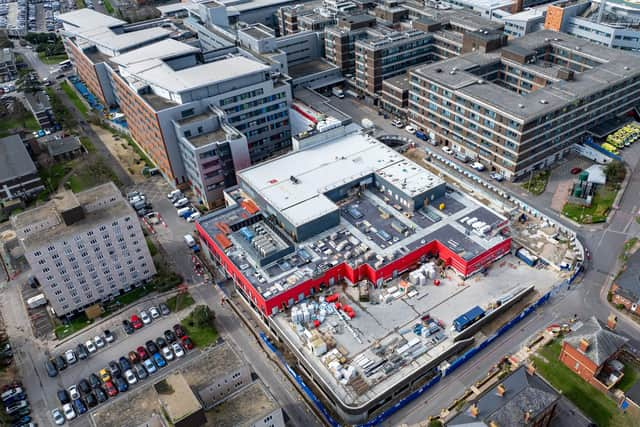New QA emergency department will be 'more efficient' health bosses say
and live on Freeview channel 276
Hampshire County Council has been given an update on the work to build a new emergency department (ED) at Portsmouth’s Queen Alexandra (QA) Hospital. Building began in March 2023 with a national investment of £58m to replace the existing emergency department which was built in the 1970s.
Dr John Knighton, chief medical officer at the Portsmouth University Hospitals and the Isle of Wight NHS trusts, said that with the new unit, the hospital would become more “efficient” since the current layout has expanded and staff need to walk 20 minutes from one area to another.
Advertisement
Hide AdAdvertisement
Hide AdDr Knighton said: “In the new building, there will be ‘line of sight’ and common shared space so there would be easy staff movement around and a much more simple and visible job, and that will give efficiency in a way you can use clinical staff, particularly the more senior clinical staff.”


The new layout will include cubicles over curtained areas to improve infection prevention and control levels and space that can be adapted to provide either bedded or seated treatment space for patients who do not require a bed. He also said that the new building will “undoubtedly” be able to respond to the rising demand.
He said: “The physical rebuild of the ED will enable the emergency department team to see that all the groups of patients, those who can be deemed assessed, discharged and treated on the same day as well as those who have higher acuity care.”
Dr Knighton said that they are continually reassured through contractors that the work is on schedule and that they are “very hopeful that it will be before next winter”, with no concerns over staffing. “We had no suggestion that there would be a delay at any stage of the process. I think we’re highly confident that it will be delivered at this time.”
Advertisement
Hide AdAdvertisement
Hide AdA report said the building is being made watertight with the majority of windows installed and external cladding at an advanced stage. Installation of the solar panels to provide sustainable energy to the building has begun, and floor coverings are starting to be laid. At the site, cables are being upgraded in advance of the new department opening. Work is being done in partnership with Scottish and Southern Electricity Networks to provide additional capacity, and any temporary impact on patients, visitors, and staff is being communicated in advance.
The link bridge connecting the new ED to the main hospital is now installed, helping improve access for patients being transferred for admission.
At the meeting, councillors asked about the building’s life expectancy since there are “enormous pressures to build a hospital quickly to try to satisfy public expectation”, said Cllr David Harrison.
He added: “You’re aware of the inflation as it applies to construction costs, so you’re under great pressure. In the past, we’ve made mistakes by using materials such as asbestos. What do you expect for the lifespan of this hospital building? The contractual period for which we expect without significant change that the building is meant to be functional as it is built is 30 years. Of course, its lifespan will be much longer than that, but that’s it as a design and builds expectations.
Advertisement
Hide AdAdvertisement
Hide Ad“We’ve got experience as a trust at making sure that the clinical design, which is what’s really important, is fit for the purpose, for not just here and now, but also for the future, and of course, we can’t predict what material might have been used that in the future may be deemed to be inappropriate.
“In terms of clinical design, we are pretty confident that it is the right build for the purpose of its design and that the building methodology and infrastructure will be fit for purpose for the next few decades.”